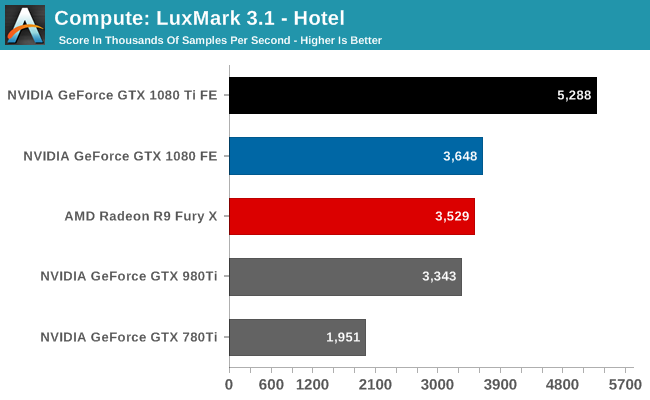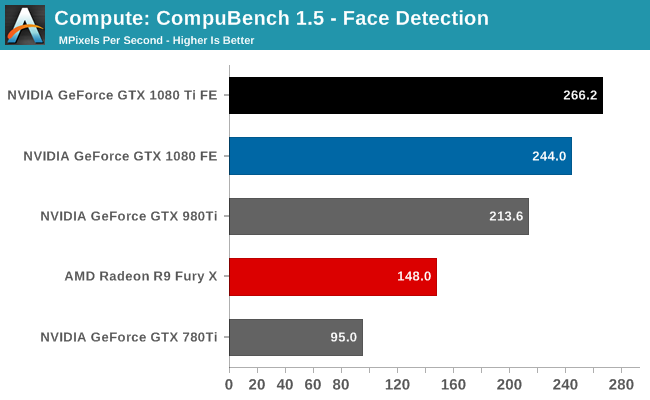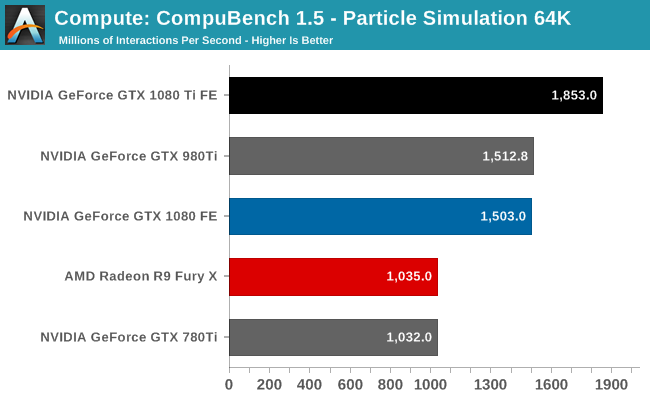The NVIDIA GeForce GTX 1080 Ti Founder's Edition Review: Bigger Pascal for Better Performance
by Ryan Smith on March 9, 2017 9:00 AM ESTCompute
Shifting gears, let’s take a look at compute performance on GTX 1080 Ti.
Starting us off for our look at compute is LuxMark3.1, the latest version of the official benchmark of LuxRender. LuxRender’s GPU-accelerated rendering mode is an OpenCL based ray tracer that forms a part of the larger LuxRender suite. Ray tracing has become a stronghold for GPUs in recent years as ray tracing maps well to GPU pipelines, allowing artists to render scenes much more quickly than with CPUs alone.

The OpenCL situation for NVIDIA right now is a bit weird. The company is in the middle of rolling out OpenCL 2.0 support to their video cards – something that I had actually given up hope on until it happened – and as a result their OpenCL drivers are in a state of flux as company continues to refine their updated driver. The end result is that OpenCL performance has dipped a bit compared to where the GTX 1080 launched at back in May, with said card dropping from 4138 points to 3648 points. Not that the GTX 1080 Ti is too fazed, mind you – it’s still king of the hill by a good degree – but the point is that once NVIDIA gets their drivers sorted out, there’s every reason to believe that NVIDIA can improve their OpenCL performance.
For our second set of compute benchmarks we have CompuBench 1.5, the successor to CLBenchmark. CompuBench offers a wide array of different practical compute workloads, and we’ve decided to focus on face detection, optical flow modeling, and particle simulations.



Like LuxMark, CompuBench shows some minor performance regressions on the GTX 1080 as compared to the card’s launch. None the less, this doesn’t do anything to impede the GTX 1080 Ti’s status as the fastest of the GeForce cards. It dominates every sub-benchmark, including Optical Flow, where the original GTX 1080 was unable to pull away from AMD’s last-generation Radeon R9 Fury X.










161 Comments
View All Comments
eddman - Friday, March 10, 2017 - link
Adjusted for inflation: http://i.imgur.com/ZZnTS5V.pngMeteor2 - Friday, March 10, 2017 - link
Great charts!mapesdhs - Saturday, March 11, 2017 - link
Except they excude the Titans, Fury, etc.eddman - Saturday, March 11, 2017 - link
I, personally, made these charts.No titans because they are very niche cards for those gamers who cannot wait and/or have more money than sense. The following Ti variants perform almost as good as the titan cards anyway.
No radeons because this is an nvidia-only chart. I should've titled it as such. I focused on nvidia because ATI/AMD usually don't price their cards so high.
mapesdhs - Saturday, March 11, 2017 - link
Ok on the Radeon angled, shoulda realised it was NV only. :DHowever, your description of those who buy Titans cannot be anything than your own opinion, and what you don't realise is that for many store owners it's these very top-tier cards which bring in the majority of their important profit margins. They make far less on the mainstream cards. They enthusiast market is extremely important, whether or not one individually regards the products as being relevant for one's own needs. You need to be objective here.
mapesdhs - Saturday, March 11, 2017 - link
Sorry for the typos... am on a train, wobbly kybd. :D Is this site ever gonna get modern and allow editing??...eddman - Saturday, March 11, 2017 - link
I think I am being objective. Titan cards do not fit into the regular geforce range. They are like an early pass. Wait a few months and you can have a Ti that performs the same at a much lower price.If nvidia never released a similar performing Ti card, I would've included them.
eddman - Saturday, March 11, 2017 - link
Also I don't see how stores and their profits has anything to do with that.Mr Perfect - Tuesday, March 14, 2017 - link
Nice work on those charts.So there where a couple years where top tier cards where $400 or less. Inflation number normalize that price a fair bit though.
Ryan Smith - Thursday, March 9, 2017 - link
Those days are long-gone, and not just because of profit taking. 16/14nm FinFET GPUs are astonishingly expensive to design and fab. The masks are in the millions, and now everything has to be double-patterned.